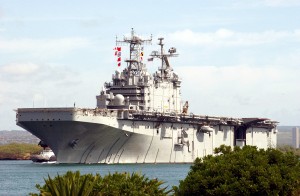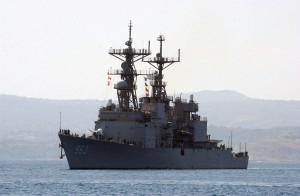"First-in-Class Acquisition Challenges"
16 April 2015 – Justin Eldridge
Editor’s Note: This series showcases the winners of the National Council on Public History’s awards for the best new work in the field. Today’s post is by Justin L.C. Eldridge, a government historian with the Naval History and Heritage Command, whose monograph First in Class Acquisition Challenges received Honorable Mention for the Michael C. Robinson Prize for Historical Analysis.

020628-N-3228G-001
Pearl Harbor, HI (Jun. 28, 2002)–Amphibious warfare ship USS Tarawa (LHA 1) leaves Pearl Harbor to participate in exercise “Rim of the Pacific” (RIMPAC) 2002. The purpose of RIMPAC 2002 is to enhance the tactical proficiency of the participating units in a wide array of combined operations at sea among the seven participating countries. The exercises also help build cooperation and foster mutual understanding between the participating nations. Among the countries participating this year are: Australia, Canada, Chile, Peru, Japan, the Republic of Korea, and the United States. Photo credit: Photographer’s Mate 1st Class William R. Goodwin
One task among many for government historians is to create a policy narrative in their particular field, often in an environment where it is not clear how or even whether the narrative will find favor with or influence the officials for whom they work. To most historians, the end-use of their work by decision makers does not matter, so long as the narrative is historically accurate, the historian has properly used primary source material (critical for credibility), and their work finds peer acceptance as a well-reasoned and reliable intellectual product.
Finding success-influencing policy makers comes with a different set of challenges and pitfalls. Policy development is the art of compromise, and officials may not always have the luxury of time to fully consider, let alone accept, suggestions based on historical research. They can also carelessly use or, even worse, misuse a narrative in the pursuit of political objectives. Though the responsibility for such embellishment remains with the policy maker, the historian can endure harsh criticism as a result, despite strict adherence to historiographical standards. With collaboration come both condemnation and approbation.
Policy makers may care less about a work’s intellectual underpinnings and methodology than they do about how history can help them make informed decisions or make an argument. Luckily for policy makers and other public history consumers, guidance on how to “use” history for policy formulation is available.
Richard Neustadt and Ernest May wrote Thinking in Time for “those who govern–or hope to do so.” The book, which has resided on the Navy Professional Reading Program list, includes relatively specific advice, embodied in a seven-step process, on how leaders should use past examples (reasoning from analogy) for sources of informed guidance and reliable insight to help solve or resolve current policy and governance questions. Unfortunately for the historian (especially the public historian) who researches, writes, and interprets history to understand a problem or incident, Neustadt and May offer only indirect advice on how to prepare and write history for policy makers.
Government historians often research and write on policy, not necessarily for policy. The distinction is important. In the former, the historian recounts a story and creates a policy narrative. In the latter, the historian becomes what some pejoratively call a “policy entrepreneur,” or a policy advocate. In so doing, the historian must use her narrative to bridge the wide gulf between traditional history and the needs of policy makers. This requires products that are socially, politically, or economically relevant. Creating relevant products, while maintaining sound scholarship and historical integrity, is not always direct or easy. The appetite for expedient answers to help solve complex problems therefore requires government historians, if they are to be relevant, to assume intellectual risk.
One of the important differences between accepted historical methodology and policy formulation is time. Government historians often face the quandary of writing quickly, which does not always allow for thorough research using primary source materials, precise writing, or mature reflection. The time-restricted demands of policy makers often dictate that the first draft may be the last. A fast-paced environment where partial solutions appear acceptable is not always agreeable for historians and can lead to frustration.
The Naval History and Heritage Command’s first-in-class writing project is an example of history informing policy under time constraints. The project began with a request for five information papers on two days’ notice, each on Navy experiences developing an individual ship class. Their intent was to inform decision makers about previous first-in-class ship acquisitions and to support upcoming congressional testimony on the Littoral Combat Ship. Once the Navy Staff received the initial five papers, they asked for a further six papers within a week.
At the time the project began, the Naval History and Heritage Command had interns available to conduct the initial research. We let readily available sources, chiefly congressional testimony available in the Navy’s research library, determine our ship choices. Recognizing there was considerable material in the Navy archives, we accepted that we did not have the time to fully exploit it all. Public sources of information, including contemporary press reports and secondary source material, also shaped the research.

040719-N-0780-047
Souda Bay, Crete, Greece (Jul. 19, 2004) —
USS Spruance (DD 963) arrives for a brief port visit.
Spruance is homeported in Mayport, Florida, and is currently on a routine deployment.
USS Spruance was the first of the Spruance Class Destroyers. The Spruance-class destroyers, the first large US Navy warships to employ gas turbine engines as their main propulsion system, are undergoing extensive modernizing. The upgrade program includes addition of vertical launchers for advanced missiles on 24 ships of this class, in addition to an advanced ASW system and upgrading of its helicopter capability. Spruance-class destroyers are expected to remain a major part of the Navy’s surface combatant force into the 21st century. Photo credit: Paul Farley
After completing the initial eleven papers, we had time to review more thoroughly both the congressional hearings and an enormous amount of previously unused material in the Navy archives. We then pursued more in-depth studies of the ships and how their acquisition reflected contemporary Navy strategy. I began two “White Papers,” a Pentagon method to raise issues and concepts, on the Tarawa amphibious assault ship and Spruance destroyer classes. In draft, both papers exceeded 120 pages, too long for immediate use by Navy decision makers. Despite their length, after several months of research and writing, the Navy Staff asked to see both drafts.
At this point the project had taken on a life of its own. The two white papers were insufficient vehicles to convey the broad scope of Navy ship acquisition experiences, to include the interaction between organizations, institutions, and individuals. A book-length manuscript was the next logical step. Several interns helped research a third ship type, the Fast Deployment Logistic ship, first designed (though not built) under Secretary of Defense Robert S. McNamara’s controversial Total Package Procurement (TPP) process. The other two TPP-designed and -built ships were the Tarawa and Spruance ship classes. Together, the three vessels became case studies for a book-length manuscript on Navy strategy and warship acquisition in the 1960s and early 1970s. The topic’s nature required an in-depth discussion, not included in the original eleven papers, on the often tense relationship between the Navy’s uniformed leaders, the Secretary of Defense, Congress, and the Secretary of the Navy. This book-length manuscript is currently in draft form, and, like all previously incomplete material, remains immediately available to Navy Staff as required.
The project began as a rushed answer to questions from Navy officers. Answering the questions built room for a durable monograph, of potentially long-term value to the Navy, scholars, and the public.
~Justin Eldridge retired after nearly 22 years of active duty in the Army. He has served as a law enforcement officer and currently works as a historian and analyst at the Navy History and Heritage Command in Washington, DC.




Favorite quote “One task among many for government historians is to create a policy narrative in their particular field, often in an environment where it is not clear how or even whether the narrative will find favor with or influence the officials for whom they work.”